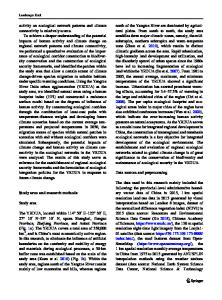Evolving Characteristics of High-Speed Railway Network Structure in Yangtze River Delta, China: the Perspective of Passe
- PDF / 2,420,639 Bytes
- 19 Pages / 439.37 x 666.142 pts Page_size
- 29 Downloads / 499 Views
Evolving Characteristics of High-Speed Railway Network Structure in Yangtze River Delta, China: the Perspective of Passenger Flows Sheng Wei 1,2 & Jingjuan Jiao 3 & Lei Wang 4,5 & Jiangang Xu 1 Received: 12 September 2019 / Accepted: 27 January 2020/ # Springer Nature B.V. 2020
Abstract China’s high-speed railway (HSR) network is the largest planned network operating globally. Compared to other HSR networks, it has a unique and complicated structure. Multiple studies explored the supply side network structure of HSR services through train frequency data. However, due to data collection difficulties, there is limited research that studies the evolving characteristics of HSR development by using passenger flow data on the demand side network. This paper explores the evolving characteristics of the HSR network in the Yangtze River Delta (YRD), one of the most developed megaregions of China. HSR passenger flow data from the timeframe of 2014 to 2018 are used to examine the evolution of topological structure, hierarchical structure, and the spatial structure of the HSR network. Results indicate that the topological structure of the HSR network has been relatively stable, and has a roughly normal distribution. Although it is a relatively stable HSR network, a hierarchical structure exists, and there is a certain degree of variability among the third-tier cities. Based on the weighted degree centrality, and structural holes of passenger flow network in the YRD, Shanghai, Hangzhou, Nanjing, and Hefei, were identified. Correspondingly, four network communities were formed, and they varied across the evolutionary characteristics over the study period. The study proposes that in the planning of the HSR network, more focus should be given to connections between sub-regional nodes, in addition to connecting the core nodes. Additional relevant planning strategies are proposed based on the conclusions reached. Keywords High-speed rail . Network structure . Passenger flow . Regional planning .
Yangtze River Delta
Sheng Wei and Jingjuan Jiao contributed equally to this work.
* Lei Wang [email protected] Extended author information available on the last page of the article
S. Wei et al.
Introduction Although China’s high-speed railway (HSR) network is already the largest system in the world, it is still undergoing rapid expansion in the coming years. By the end of 2018, HSR lines in China had reached a total length of about 29,000 km, and it accounted for approximately two-thirds of the commercial operating HSR lines in the world. The Chinese railway ticketing website (http://www.12306.cn) contains information on all HSR trains, including their routes and stations, with Hong Kong, Macau and, Taiwan excluded (Wei et al. 2019). The data from the railway ticketing website show that there were 987 HSR stations in China by the end of March 2019, which increased to 283 HSR stations from the end of June 2016. According to the national “Mid-to-long Term Railway Development Plan,” which was revised in 2016, the HSR building boom in
Data Loading...











